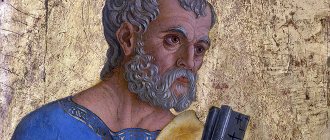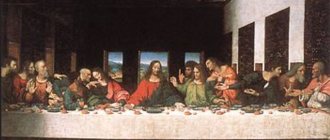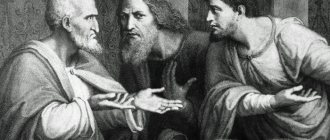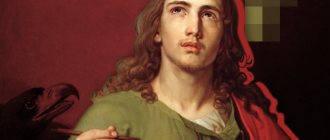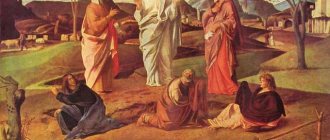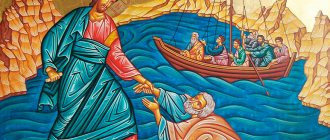The Supreme Apostle Peter is a simple and illiterate fisherman who conquered the entire pagan world. Brave, strong in faith and character. The Teacher called him a stone - but he denied Him. After tearful repentance, it was to him that Jesus commanded to be a shepherd and entrusted him with the keys to the Kingdom of God.
Image of the Apostle Peter. Sinai, monastery of St. Catherine. The oldest encaustic icon of the 6th century, painted on a board
Apostolic service with Christ, fortitude, ardor and denial of Peter
The glorious biography of the Apostle Peter begins with Jesus' call to apostolic ministry. This proposal came to Simon while he was fishing. With him in the boat was the brother of the Apostle Peter, Andrew the First-Called.
“The Calling of the Apostles Andrew and Peter”, Duccio di Buoninsegna, XIV century
Peter - beloved and revered of the Apostles
When listing the apostles, Peter always comes first. He is the closest disciple of Jesus, accompanying Him throughout his entire life.
(Mark 1:29-31)
The Lord visited Peter's home. There He healed Peter's mother-in-law from a fever
Christ chose Apostle Peter to see miracles with his own eyes.
Miracles that Peter saw:
(Matt. 17:1-9)
Appearance of Divine Glory on Mount Tabor
Icon "Transfiguration of the Lord", XV century.
Kirillo-Belozersky Museum. Below are the Apostles Peter, John and James (Luke 8:41-56)
Christ raised the dead daughter of Jairus
"The Resurrection of Jairus' Daughter."
Painting by M.M. Zelensky, 1871. The Apostle Peter is behind Christ (Matthew 26:37-41)
Prayer vigil of Jesus in the Garden of Gethsemane
Gethsemane prayer.
Jesus is depicted with the Apostle Peter. Venice, Italy. Mosaic of St. Mark's Cathedral, XIII century (Matthew 14:28-31)
The Apostle Peter, the only one of the disciples, dares to walk on water.
Icon “The Rescue of the Drowning Apostle Peter”
Jesus said to Him: “You are Peter, and on this rock I will build My Church.”
Peter is the first of the Apostles to recognize Jesus as the Messiah and call Him the Son of God.
(Matt. 16:15-18)
“He says to them: Who do you say that I am? Simon Peter answered and said: You are the Christ, the Son of the Living God. Then Jesus answered and said to him, Blessed are you, Simon son of Jonah, because flesh and blood has not revealed this to you, but My Father who is in heaven; and I say to you: you are Peter, and on this rock I will build My Church, and the gates of hell will not prevail against it.”
Christ by the word “on this rock” means Himself.
Faith in the Savior is the cornerstone, about which the Apostle Peter later speaks in his letter:
(1 Peter 2:7-8)
“He is a precious thing to you who believe, but to those who do not believe, the stone which the builders rejected, but which has become the head of the corner, is a stone of stumbling and a stone of offense, over which they stumble, not obeying the word, to which they are abandoned.”
Jesus also made Peter the keeper of the keys of the Kingdom of Heaven.
Peter is called the “Keeper of the Keys.” This follows from the words of Christ:
(Matt. 16:19)
“I will give you the keys of the kingdom of heaven: and whatever you bind on earth will be bound in heaven, and whatever you loose on earth will be loosed in heaven.”
Monument "Apostle Peter with the Keys".
Prague, Czech Republic The keys were commanded to Peter after he, on behalf of all the disciples, confessed Jesus Christ, the Son of God. The Teacher asked all the Apostles about this - “Who do you say that I am?”
With this question addressed to all disciples, Christ indicates that all the Apostles have equal rights to bind and loosen. Their ministry is continued by the bishops whom they ordained. Bishops also have this power to this day.
Peter denied Jesus as He was being led to execution
In the Garden of Gethsemane, when they came to put the Divine Teacher to death, Peter, the only one of the disciples, took a sword in his hands and tried to protect Jesus. Despite such courage, the Lord allows him to fall.
Peter's denial. Painting by Rembrandt, 1660
Peter sincerely repented of his actions. Christ accepted the tearful repentance of the Apostle, and deigned him to be the first to see Himself risen. Subsequently, Christ restores Peter to the apostolic ministry after a threefold declaration of love.
(John 21:17)
“He says to him for the third time: Simon the Jonah! do you love me? Peter was saddened that he asked him for the third time: Do you love Me? and said to Him: Lord! You know everything; You know I love you. Jesus saith unto him, Feed my sheep."
Childhood and youth
Not all facts of the biography of historical figures are known to descendants. So one can only guess about the date of birth of the Apostle Peter. But in the gospel traditions there is an indication of the place where the saint was born - Bethsaida of Galilee, a small town in Palestine. The region of Galilee was located farthest from Jerusalem. Its territory was inhabited mainly by pagans, who later became Peter’s first flock.
Painting "Saint Peter", Marco Zoppo
At birth the apostle received the name Simon. The name Peter, which is translated from Greek as “stone,” was called by Jesus for his special devotion, implying the foundation of the Church in a faithful follower of the teaching.
Peter was married to the niece of the Apostle Barnabas and raised a daughter and son. He earned his living by simple and unpretentious work - fishing on Lake Gennesaret. An occupation that did not bring much income required perseverance and patience.
The Gospels of Matthew and John tell different stories of how Peter met Jesus and came to believe in his teachings.
Painting "Andrew Leading Peter to Jesus", Caravaggio
According to one version, Simon was brought to Jesus by brother Andrew, who became a disciple of John the Baptist and learned from him about the Messiah. Jesus, looking at Simon, called him Cephas (in Aramaic - “stone”, Peter - in Greek). The stone is allegorically the faith on which the Church is built.
According to another, the Lord found the brothers while fishing on the shore of the lake, and addressed them with the words:
"Follow me. I will make you fishers of men."
Jesus showed the deep meaning of the phrase by filling the boats of Peter and Andrew to the brim with fish.
Jesus Calls Peter and Andrew
Researchers see no contradiction between the two narratives. They believe that Matthew emphasized the lives of ordinary people engaged in hard work. While John emphasized that long before meeting the Lord, the fishermen were spiritual, they listened to sermons and prepared for the coming of the Messiah.
Ministry after Pentecost - wanderings, preaching and death on the cross
After Holy Pentecost, Christ's disciples become Apostles, endowed with the power of the Holy Spirit. On the same day, the Apostle Peter preaches his first sermon, after which “about three thousand souls” joined the Church of Christ (Acts 2:14-41).
The Apostle proved his love for Christ with ardent sermons and patience with sorrows and persecutions. His activities were accompanied by signs and wonders. Peter, through his prayers to the Lord, raised the lame (Acts 3:1-8), raised the dead (Acts 9:40), and healed the sick (Acts 9:32-34). When Peter passed through the villages, they “carried out the sick into the streets and laid them on beds and beds, so that at least the shadow of Peter passing would overshadow any of them. Many from the surrounding cities also converged on Jerusalem, bringing the sick and those possessed by unclean spirits, who were all healed” (Acts 5:15-16).
37 year
Through the efforts of Peter, the Antioch and Roman Churches were formed
The apostle traveled a lot. He made six journeys from Jerusalem. He preached Jesus Christ in Galilee, Judea, Samaria, Syria, Antioch and Caesarea, Phenicia, Pontus and Galatia, Cappadocia, Troy, Bithynia, Rome, Babylon, Greece and Britain.
Saint Peter did a lot for the conversion of the pagans, for which the authorities repeatedly decided to imprison him. But the Lord was always with him. Peter was miraculously released from prison by an angel (Acts 12:7-10).
Peter, the first of the apostles, was visited by a vision from the Lord, so that the Jews would not consider anything unclean, neither food (Acts 10:11-16), nor any person (Acts 10:28).
Peter was the Bishop of Rome from 43 to 67. In 49, he headed the Apostolic Council, which considered the issue of the procedure for accepting pagans into Christianity.
Peter's mortal combat occurred in Rome with Simon the Magus. This event was described by the ancient Greek historian Egesippus, Saint Metaphrastus, and early Christian authors Saints Justin and Irenaeus. This is reflected in the Prologue and the Great Menaions.
Simon the Magus with his witchcraft darkened the minds of many Romans to such an extent that they erected a monument to him and worshiped him as a god. The Apostle Peter, so that faithful Christians would not be tempted by false miracles, entered into single combat with the sorcerer and defeated him by the power of Christ. Peter raised a dead young man whom the sorcerer could not resurrect.
After this, Simon, lifted into the air by demons, imitated his ascension. But Peter bound the demons in the name of Jesus. Simon fell to the ground and died.
Painting by artist Benozzo Gozzoli “The Fall of Simon Magus.” 1461 g
At this time, Peter wrote his Council Epistles, which were included in the New Testament.
Dungeon Escape
During the reign of Herod Agrippa, Saint Peter was caught by persecutors of Christians and imprisoned along with the Apostle James, who was later killed. Believers in Christ continually prayed for Peter's life. The Lord heard the voice of the people, and an angel appeared in prison to Peter. The heavy shackles fell off the apostle, and he was able to leave the prison unnoticed by everyone.
Each of the students chose their own path. Peter preached in Antioch and on the Mediterranean coast, performed miracles and converted people to the Christian faith, and then went to Egypt, where he also spoke about the coming of Jesus Christ.
The letters of the Apostle Peter were included in the New Testament of the Bible, there are two of them
In the years 63 and 67, the Apostle Peter wrote his Council Epistles, which were included in the New Testament.
In the first part of the epistles, he strengthens newly converted Christians in the faith, admonishing them not to be embarrassed by threats, slander and persecution. He teaches prudence, prayer and piety. In the second letter, the Apostle calls not to retreat in faith to please the pagans, denounces false teachers and false prophets, warns and protects Christians from the errors of lawless people.
Quote from the message:
(1 Peter 1:13-16)
“Therefore, (beloved), having girded up the loins of your mind, being watchful, have complete confidence in the grace that is given to you at the appearing of Jesus Christ. As obedient children, do not conform to your former lusts that were in your ignorance, but, following the example of the Holy One who called you, be holy in all your actions. For it is written: Be holy, for I am holy.”
The letters of the Apostle Peter confirm Christians in faith, piety and firmness of conviction.
Handing over the keys to heaven
Photo: Ru.Wikipedia.org
As a result, the Lord decided to hand over the keys to heaven to the most unstable and ardent of his disciples. Scripture notes that none of the apostles who sinned received the keys. Instead, they went to Peter so that in the future he would be able to discern sincere repentance in sinners, and then remember his own fall.
It is such an apostle who is truly able to help a person who sincerely repents of his sinful actions receive salvation.
The cross and death of the Apostle Peter are the crown of his holiness
The death of the Apostle Peter was predicted by Christ. Peter writes about this in his letter: “I must soon leave my temple, just as our Lord Jesus Christ revealed to me” (2 Peter 1:14). After Peter converted Nero's two wives to Christianity, the angry emperor orders the Apostle to be crucified on the cross.
At the request of Christians, Peter leaves Rome. On the way, he meets Jesus Christ going to Rome. To Peter's question, Jesus answered that He was going to Rome to suffer again on the cross. The apostle understands that the time has come to accept martyrdom. He is arrested, put in prison, and a few days later sent to execution.
Apostle Peter was executed in 67, on June 29.
How the Apostle died is described in detail in the Holy Tradition by Saint Metaphrastus. Peter asks his executioners to nail him upside down. The reason for this is deep repentance due to his renunciation, and the awareness of his unworthiness to be crucified like Christ. The condemned man’s request was fulfilled, and Apostle Peter was nailed upside down on the cross.
Transfiguration
Before Jesus Christ was arrested and then crucified on the cross, he appeared to three of his disciples (Peter, James and John) in God's guise on the At that moment, the apostles also saw the prophets Moses and Elijah and heard the voice of God the Father instructing the disciples. The saints saw the Kingdom of Heaven while not yet being physically dead. After the miraculous Transfiguration, the Lord forbade his disciples to talk about what they saw. And again, the Apostle Peter was called to see the greatness of God, thereby drawing even closer to the Kingdom of Heaven.
The tomb of the Apostle Peter was found in the 20th century
Christian tradition has preserved information that the ancient Roman basilica of Constantine was located at the site of the supposed burial of the Apostle. Archaeological excavations carried out in 1939-1949 discovered ancient remains, and a stone with the inscription “Here lies Peter.” The research report reflects the assumption that, with a high probability, the remains and grave belonged to the Apostle. After studying the materials, in 1968, Pope Paul VI announced the discovery of the tomb of the Apostle Peter.
The veneration of the Supreme Apostles Peter and Paul takes place on June 29.
By leaving a comment, you accept the user agreement
James (not John's brother)
Theory 1: Jacob was crucified during his ministry in Egypt (Keep in mind, the source of this information is Wikipedia. So take it with a grain of salt).
Theory 2: Jacob "died as a martyr and his body was sawn into pieces."
Theory 3: In his old age, he was beaten, stoned and clubbed on the head.
Theory 4: Jacob was preaching on the wall when the Jewish religious leaders decided to throw him down. Apparently he survived, so like the third theory, they stoned him and clubbed him to death.
